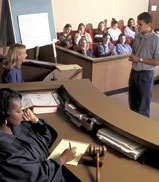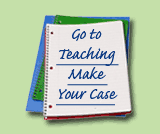
 Game InstructionsFrom Unit Plan: Justice by the PeopleClosing Arguments: Once all four witnesses have testified, the judge instructs the jury on how to apply the law in the case. The trial then ends with closing arguments. Players choose what to emphasize in their closing statements. Each closing argument will only mention items that were introduced as evidence during the trial. Hence, the players who introduced stronger evidence in support of their case will have stronger closing arguments and will earn more points. Jury Deliberation: Following closing arguments, the jury deliberates the following questions:
The Verdict: Finally, the jury returns its verdict, which is based on how an average jury would be likely to respond to the evidence presented, and not on the scores achieved by either attorney. If you are playing the game with a student jury, stop the game after closing arguments and allow your jurors to reach their own decision. Their verdict can then be compared with that of the game’s jury. Juror Interviews: After the verdict is delivered, students may interview three of the jurors for feedback on the trial. The jurors’ responses will depend upon the evidence presented during the trial. Finally, players can print out certificates of completion that show how they scored. Concluding the Lesson
To return to page 1, click here. View and print using Adobe Acrobat Reader® software, version 4.0 or higher. Get Adobe Reader® for free. |
Download the Make Your Case Trial Simulation here. Photos: © Digital Vision/Getty Images; © Rubberball Productions/Getty Images; © C Squared Studios/Photodisc/Getty Images; © George Doyle & Ciaran Griffin/Stockdisc/Getty Images; © Siede Preis/Photodisc/Getty Images; © David Toase/Photodisc/Getty Images; (2) © Bob Daemmrich/The Image Works; Bob Daemmrich/PhotoEdit, Inc.; © Bob Daemmrich/The Image Works. |



